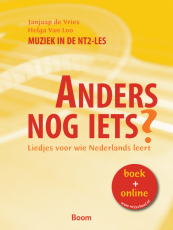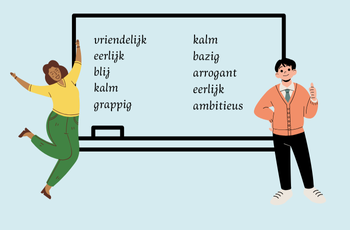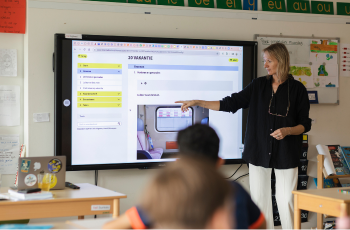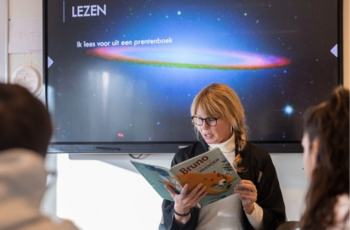Music in class
Scientific research on music in the language classroom
Although it may not be immediately obvious, there is a strong relationship between music and language. Several studies have shown that language and music use closely related neurocognitive systems. In fact, music and language are processed in the same part of the brain. This brain area is crucial for processing sentences and, according to recent research, helps musicians understand musical pieces.
The use of music and music-based tasks in language class have been shown to have a major positive impact on the language acquisition process. Music helps learn new words and phrases. After all, it is easier to memorize songs than dry lists of words. Music can also help learn the rhythms and intonations of a new language. By listening to music and singing in the new language, the student can get used to the sounds and pronunciation. This can speed up the learning process and make it easier to understand and speak the language.
Emotions through music
Many NT2 teachers are already familiar with the positive effect of language rhymes: short conversations to a fixed rhythm that help ingrain certain fixed language tasks, such as apologizing and saying goodbye. The effect of music is even greater. It gives emotions and creativity more space. And that is important, because newcomers have often already had to go through a lot.
Not being able to put emotions into words can evoke feelings of powerlessness and frustration. A song containing Dutch concepts and words that express feelings of sadness, happiness, tension and homesickness thus takes on an expressive function.
To further help your students express their emotions, you can also attach assignments to the songs. Could you use some help with this? The book Smartlappen contains songs and assignments to increase vocabulary around emotions and to discuss emotions in class. Highly recommended for elementary schools and ISKs.
Self-confidence with music in the NT2 lesson
Singing together is also a safe and fun way to initiate speaking skills in students and trainees and thus build self-confidence. Singing together happens in many schools in many cultures. For most pupils and students it is therefore a familiar activity.
Several studies have additionally shown that music helps increase motivation to learn a language. Music can also help create a more inclusive and participatory learning environment, where learners are encouraged to actively participate and collaborate. It helps to learn more about the music and culture of the country of the target language, which can contribute to a better understanding of the country's history and traditions.
Forms of work with music in NT2 lessons
OK, so the benefits are great. But if you want to take music in NT2 lessons seriously, it is important that it becomes more than the five minutes of padding at the end of the lesson. We'll give you two examples from the book Anders nog iets?
Imperfect past tense with Annabel
Suppose you are going to talk about the irregular forms of the imperfect past tense (ovt). Your students have already seen the regular form and probably already know some irregular forms passively. The song Annabel by Hans de Booij lends itself perfectly to a lesson around the irregular ovt forms.
You can give students a hole text in which all ovt forms are omitted. While listening to the song, they should then fill in the correct shapes. Have the students list the shapes while you arrange them on the board. The forms will stick more easily this way than if they are presented in a dry list. Want to get started with the imperative? Then Dad by Doe Maar is a suitable song.
Themes with Pippi Longstocking
Another example is more theme-related. Suppose you want to talk about traveling. Then you could, for example, play the song Op reis from the musical Pippi Longstocking and afterwards put all the words related to travel in a word rose.
Hole Text
If you want your students to be a little more productive, then you can give them a text in advance, each time missing a word that rhymes with another word. Before listening to the song, have them try to fill in the gaps. Looking for logical rhyming words creatively activates their vocabulary knowledge and makes the task fun. It undoubtedly creates a 'hurrah' feeling when they find most of the words afterwards. Fun and motivating!
Language acquisition remains the main goal
Of course, the goal is always language acquisition and not to turn it into a disco. If you want to add music to the lesson, there are a few things you should pay attention to. The most important thing is that the topics of the songs are relevant and consistent with the topics that are currently covered in the lesson. That way, students can make the connections their own.
In addition, songs should recur frequently and methodically. It can be difficult to find Dutch songs that are simple enough for adults and that connect to the everyday language that students encounter in practice. Moreover, songs often contain a lot of imagery. Think carefully about the right material. Not every song is suitable for use in NT2 lessons. The right material has a strong, easy-to-sing along melody, simple lyrics and contains a lot of repetition of key phrases and concepts.
Also be sure to connect useful assignments to the music. The accessible NT2 Cahier Music in the Lesson contains songs, language rhymes and related assignments developed especially for NT2 lessons. In the familiar book Anders nog iets? you will also find a wide range of songs and assignments at all levels, specially developed for NT2 lessons.
The teacher's attitude
A final, very important factor for the successful use of music in class is the attitude of the teac
Scientific research on music in the language classroom
Although it may not be immediately obvious, there is a strong relationship between music and language. Several studies have shown that language and music use closely related neurocognitive systems. In fact, music and language are processed in the same part of the brain. This brain area is crucial for processing sentences and, according to recent research, helps musicians understand musical pieces.
The use of music and music-based tasks in language class have been shown to have a major positive impact on the language acquisition process. Music helps learn new words and phrases. After all, it is easier to memorize songs than dry lists of words. Music can also help learn the rhythms and intonations of a new language. By listening to music and singing in the new language, the student can get used to the sounds and pronunciation. This can speed up the learning process and make it easier to understand and speak the language.
Emotions through music
Many NT2 teachers are already familiar with the positive effect of language rhymes: short conversations to a fixed rhythm that help ingrain certain fixed language tasks, such as apologizing and saying goodbye. The effect of music is even greater. It gives emotions and creativity more space. And that is important, because newcomers have often already had to go through a lot.
Not being able to put emotions into words can evoke feelings of powerlessness and frustration. A song containing Dutch concepts and words that express feelings of sadness, happiness, tension and homesickness thus takes on an expressive function.
To further help your students express their emotions, you can also attach assignments to the songs. Could you use some help with this? The book Smartlappen contains songs and assignments to increase vocabulary around emotions and to discuss emotions in class. Highly recommended for elementary schools and ISKs.
Self-confidence with music in the NT2 lesson
Singing together is also a safe and fun way to initiate speaking skills in students and trainees and thus build self-confidence. Singing together happens in many schools in many cultures. For most pupils and students it is therefore a familiar activity.
Several studies have additionally shown that music helps increase motivation to learn a language. Music can also help create a more inclusive and participatory learning environment, where learners are encouraged to actively participate and collaborate. It helps to learn more about the music and culture of the country of the target language, which can contribute to a better understanding of the country's history and traditions.
Forms of work with music in NT2 lessons
OK, so the benefits are great. But if you want to take music in NT2 lessons seriously, it is important that it becomes more than the five minutes of padding at the end of the lesson. We'll give you two examples from the book Anders nog iets?
Imperfect past tense with Annabel
Suppose you are going to talk about the irregular forms of the imperfect past tense (ovt). Your students have already seen the regular form and probably already know some irregular forms passively. The song Annabel by Hans de Booij lends itself perfectly to a lesson around the irregular ovt forms.
You can give students a hole text in which all ovt forms are omitted. While listening to the song, they should then fill in the correct shapes. Have the students list the shapes while you arrange them on the board. The forms will stick more easily this way than if they are presented in a dry list. Want to get started with the imperative? Then Dad by Doe Maar is a suitable song.
Themes with Pippi Longstocking
Another example is more theme-related. Suppose you want to talk about traveling. Then you could, for example, play the song Op reis from the musical Pippi Longstocking and afterwards put all the words related to travel in a word rose.
Hole Text
If you want your students to be a little more productive, then you can give them a text in advance, each time missing a word that rhymes with another word. Before listening to the song, have them try to fill in the gaps. Looking for logical rhyming words creatively activates their vocabulary knowledge and makes the task fun. It undoubtedly creates a 'hurrah' feeling when they find most of the words afterwards. Fun and motivating!
Language acquisition remains the main goal
Of course, the goal is always language acquisition and not to turn it into a disco. If you want to add music to the lesson, there are a few things you should pay attention to. The most important thing is that the topics of the songs are relevant and consistent with the topics that are currently covered in the lesson. That way, students can make the connections their own.
In addition, songs should recur frequently and methodically. It can be difficult to find Dutch songs that are simple enough for adults and that connect to the everyday language that students encounter in practice. Moreover, songs often contain a lot of imagery. Think carefully about the right material. Not every song is suitable for use in NT2 lessons. The right material has a strong, easy-to-sing along melody, simple lyrics and contains a lot of repetition of key phrases and concepts.
Also be sure to connect useful assignments to the music. The accessible NT2 Cahier Music in the Lesson contains songs, language rhymes and related assignments developed especially for NT2 lessons. In the familiar book Anders nog iets? you will also find a wide range of songs and assignments at all levels, specially developed for NT2 lessons.
The teacher's attitude
A final, very important factor for the successful use of music in class is the attitude of the teacher. Of course it will be very exciting to sing in front of a group for the first time. But remember that the students know that you are not a professional singer. So don't be afraid to make mistakes; after all, it's all about the language transfer.
A few tips for the NT2 teacher who does not dare to sing:
- Your attitude is essential, make sure you show that you enjoy doing it and that making mistakes is not a problem. In this way you create an atmosphere that is inviting and you ensure that students feel free and are more likely to sing along. And that in turn makes it easier for you.
- Start low-key and choose simple songs that are easy to sing and that trainees may even already know.
- Practice singing the songs beforehand so you feel more confident. Listen to recordings of the songs and sing along to learn the lyrics and melody.
- Involve the trainees in singing as soon as possible; this makes it a joint activity and takes a little of the pressure off you. For example, you can also let the trainees choose which songs they want to sing or let them add to the lyrics. This makes it even more fun and interactive.
- Focus on the students and their learning experience rather than on yourself and your nerves. Think about how the music can help them learn the language and get your own motivation from that.
her. Of course it will be very exciting to sing in front of a group for the first time. But remember that the students know that you are not a professional singer. So don't be afraid to make mistakes; after all, it's all about the language transfer.
A few tips for the NT2 teacher who does not dare to sing:
- Your attitude is essential, make sure you show that you enjoy doing it and that making mistakes is not a problem. In this way you create an atmosphere that is inviting and you ensure that students feel free and are more likely to sing along. And that in turn makes it easier for you.
- Start low-key and choose simple songs that are easy to sing and that trainees may even already know.
- Practice singing the songs beforehand so you feel more confident. Listen to recordings of the songs and sing along to learn the lyrics and melody.
- Involve the trainees in singing as soon as possible; this makes it a joint activity and takes a little of the pressure off you. For example, you can also let the trainees choose which songs they want to sing or let them add to the lyrics. This makes it even more fun and interactive.
- Focus on the students and their learning experience rather than on yourself and your nerves. Think about how the music can help them learn the language and get your own motivation from that.


_w173_h400.jpg)
















